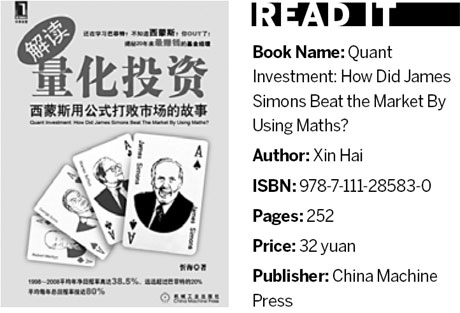Book review: Mastering markets using mathematics

The numbers tell the story of James Simons' success. He's a man whose financial acumen overshadows titans such as Warren Buffett and George Soros
Since he took charge of Medallion Fund, which was established in 1988, its average annual yield rate has been 38.5 percent, nearly twice Buffett's 20 percent.
Simons was voted the best profitable funds manager in 20 years in the Alpha 2008 Most Profitable Hedge Funds Manager Ranking List. He was crowned the new king of hedge funds that year as the Medallion Fund realized an 80 percent net income ratio. The financier increased his value by $112.5 billion over 2007. No wonder the Financial Times called him the wisest billionaire in the world.
In the book Quant Investment: How Did James Simons Beat the Market By Using Maths?, author Xin Hai says investment can be divided into two strategies: judgmental and quantitative. The former, which George Soros, Warren Buffett and Peter Lynch adhere to, involves deciding how much you will buy or sell, at what price and when to end your performance based on various data and personal experiences. Quantitative investment, however, employs mathematical models by using specific targets and parameters and then tracing the analysis of market-avoiding emotional disturbance. With the help of powerful computers analyzing individual shares, numbers, prices and times among other variables, quantitative investment seeks to ensure the best profits with the minimum risk. This is the approach Simons takes. He is not only an investor but also a mathematician. In the field of mathematical research, he is regarded as a genius and a great scholar. He established the famous Chern-Simons Form with the famous Chinese scientist Chen Xingshen and won the highest mathematics honor in the US. It is number-crunching that makes Simons the undefeated, outstanding and the most profitable funds manager. As a mathematician, Simons knows there is only a 50 percent chance to win by luck, so careful and precise calculation is necessary to beat the market. He likes to be called Mr Model because he thinks modeling is a specialist method of decreasing risks. He says one could be a millionaire one night but be left with empty hands the next day if one solely relied on personal judgment in selecting stocks.
(China Daily 06/21/2010 page17)














